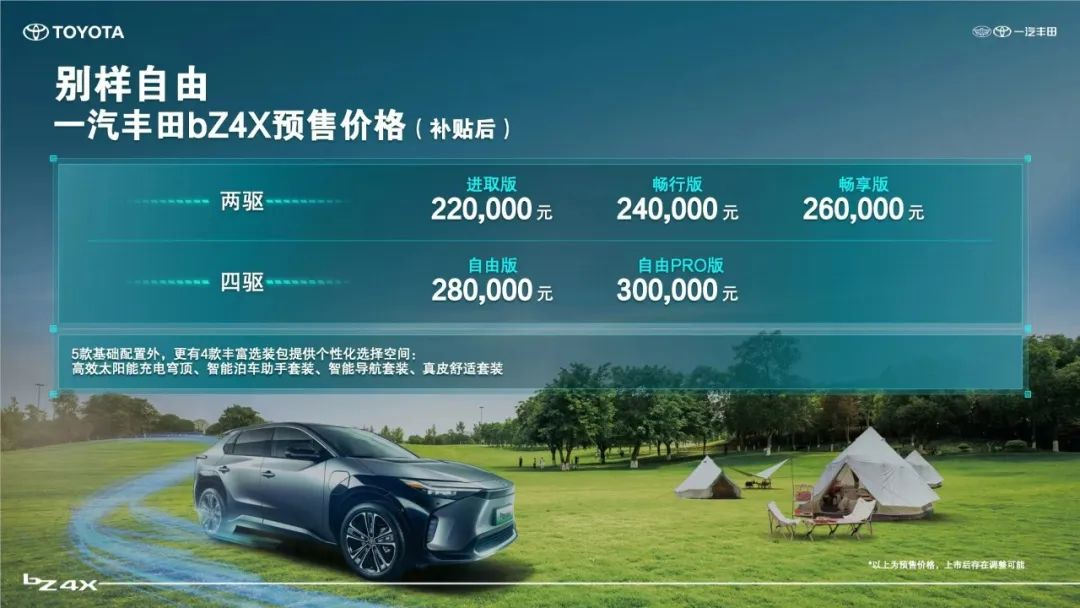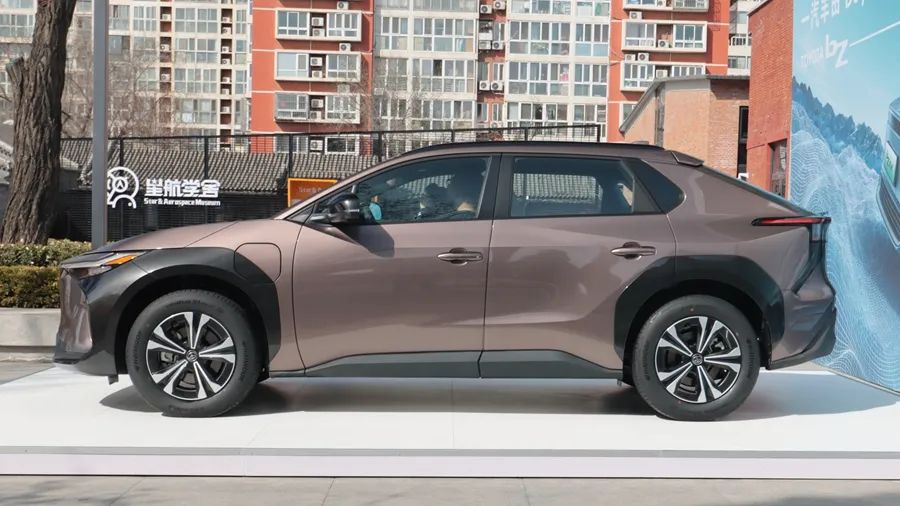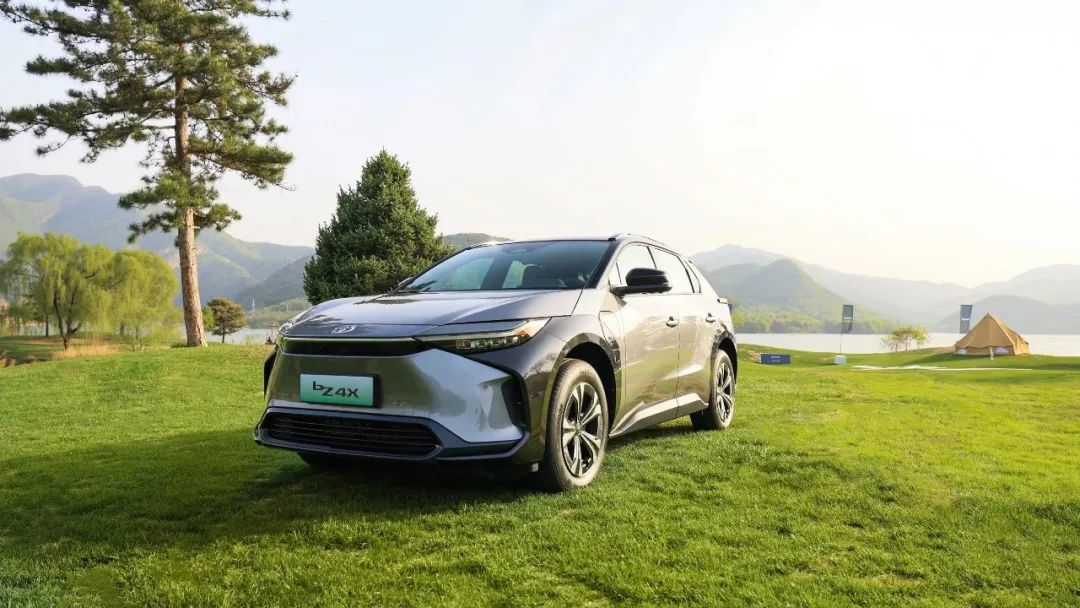Author | Tian Hui
Editor | Qiu Kaijun
Chinese domestic automakers have been making great progress in the field of electric vehicles, while traditional car giant Toyota, what about them?
Toyota also has pure electric models. However, models such as the CH-R EV and UXe have not been able to leave a mark in the hearts of consumers. Instead, the Toyota iA5 model with the Guangqi logo has sold well.
If Toyota does not take action, the brand will be in danger.
Therefore, Toyota has launched the bZ series of electric vehicles. bZ stands for Beyond Zero, which means unique freedom. On April 28th, FAW Toyota officially announced the presale of the pure electric SUV Beyond Zero bZ4X.
Unlike Toyota’s gasoline cars that are produced by FAW Toyota and GAC Toyota respectively, the bZ4X uses a unified naming, indicating Toyota’s eagerness to focus on breaking through the electric vehicle market.
However, the pricing of the FAW Toyota bZ4X is not cheap. The pure electric SUV model, which can run up to 615 kilometers under CLTC working conditions, has a presale price of 220,000-300,000 yuan.

30 million yuan is not the highest selling price. Consumers can also choose to add a “solar panel with an annual increase of 1,750 kilometers of endurance,” which will push the final selling price over 30 million yuan.
Such a high price, as well as the negative example of the mediocre sales of the Volkswagen ID series, makes people feel nervous about the FAW Toyota bZ4X.
Can the bZ4X succeed? Can Toyota’s bZ series electric vehicles catch up in the field of electric vehicles?
We have to return to the product itself.
e-TGNA architecture is also promising
The FAW Toyota bZ4X is a model based on the e-TNGA architecture.
The TNGA architecture has proven to be promising in the field of gasoline cars, while the e-TNGA architecture has not yet shown its true strength in the field of electric vehicles, and is even a subject of doubt.
Is e-TNGA a pure electric exclusive architecture? This has been a question of doubt for a long time, and the bZ4X provides an answer.
 The wheelbase of bZ4X is as long as 2850mm, but the overall length is only 4690mm, and the ratio of wheelbase to vehicle length exceeds 60%. The first advantage of the long wheelbase is the larger interior space, where the longitudinal space of the second row of seats can reach up to 1000mm at the extreme.
The wheelbase of bZ4X is as long as 2850mm, but the overall length is only 4690mm, and the ratio of wheelbase to vehicle length exceeds 60%. The first advantage of the long wheelbase is the larger interior space, where the longitudinal space of the second row of seats can reach up to 1000mm at the extreme.
The ratio of wheelbase to vehicle length exceeding 60% proves that e-TNGA is a truly dedicated architecture for electric vehicles, and the benefits it brings are also very intuitive. Not only bZ4X, but other bZ series models to be launched in the future can also enjoy the benefits brought by e-TNGA.
In terms of electrification, the bZ4X equipped with the e-TNGA architecture uses a very complex whole vehicle thermal management system. The densely packed pipeline design in the front compartment is completely different from the high-integration design style represented by Tesla and BYD.
The reason why such a complex thermal management system is adopted is that Toyota hopes to provide independent thermal management functions for both the cabin and the power battery, so as to achieve better performance in passenger comfort and power battery safety.
The conservative and traditional design thinking of Toyota in the electric field leadership is not necessarily backward. From bZ4X, we can see that the advantages brought by e-TNGA are that each subsystem is independent, and has better performance in terms of system complexity and maintenance difficulty.
The bZ4X is not a traditional car. It will launch a version with a wire-controlled steering function.
The steering system of the automobile has gone through the evolution process from pure mechanical steering system, hydraulic power steering system, to electric power steering. At present, most electric vehicles use electric power steering (EPS) system, which is sensitive, reliable, and consumes less power.
The biggest difference between the wire-controlled steering system adopted by bZ4X and EPS is that the physical connection between the steering wheel and the steering wheel is eliminated. When the steering wheel is turned, the angle of the steering wheel is converted into an electrical signal and transmitted to the steering actuator, which controls the vehicle wheel to turn.For drivers, the benefits that steer-by-wire can bring are less road vibration and a more flexible and convenient steering feel. However, compared to EPS, steer-by-wire seems to be a non-essential technological advancement.
The real benefit of steer-by-wire is in the field of assisted driving. Since the steering wheel and the wheels are physically decoupled, the response time of the assisted driving system is improved, thus improving the reliability of the assisted driving function.
In a world where EPS electric power steering systems are widely used, Toyota’s bZ4X is the first model to adopt steer-by-wire, undoubtedly a radical choice. Of course, this is closely related to the rich assisted driving functions provided by the bZ4X.
The assisted driving functions that will be equipped on the bZ4X include Intelligent Panoramic Monitor (PVM), Pre-Collision Safety System (PCS), Lane Departure Warning System (LDA), Dynamic Radar Cruise Control System (DRCC), Lane Tracing Assistance System (LTA), Automatic High Beam (AHB), Road Sign Recognition Assistance System (RSA), Emergency Driving Stop System (EDSS), Door Misopening Warning System (SEA), and Predictive Active Driving Assistance System (PDA).
Obviously, bZ4X is not conservative, but rather very radical, as it can achieve so many assisted driving functions.
Battery and production capacity are ready.
Unlike the imported version, the power battery of FAW-Toyota bZ4X comes from Chinese supplier – CATL.
According to the official announcement, bZ4X will adopt a 72kWh ternary lithium battery. But from the actual experience and MIIT information, bZ4X’s actual available capacity is 67.5kWh, and the reduced capacity may be for safety reasons.
Toyota has always chosen manufacturers within its own supply chain system for automobile power batteries. For example, when THS hybrid models were produced in China, Toyota copied the Japanese nickel-metal hydride battery supply chain to China.
However, in the field of pure electric vehicles mainly powered by lithium-ion batteries, Toyota has not adopted this version in the Chinese market, and the power battery adopted by bZ4X comes from CATL.
In the future, the bZ series models will not only have CATL as a power battery supplier. It is almost certain that another supplier will be BYD.
As early as March 2020, BYD and Toyota established a joint venture company dedicated to the research and development of pure electric vehicles. Two years later, the first model of the two parties has taken shape and will be one of the models in the bZ series.# CATL and BYD, the two largest power battery manufacturers in China, have been locked by Toyota.
With the lack of power battery supply, Toyota has prepared a new factory for the bZ series models.
FAW Toyota has built the first overseas TNGA plant in Tianjin, with a production capacity of 200,000 vehicles/year adopting QDR manufacturing standard.
Everything is ready except for the east wind
The e-TNGA is ready, the factory is ready, the battery is ready, and the future car model planning is ready. It seems that Toyota’s bZ series is ready in every aspect, but upon closer examination, Toyota’s bZ series still lacks the “east wind”.
The “east wind” that Toyota needs is channel and marketing.
Does Toyota lack channels? Apparently not.
Just FAW Toyota alone owns 727 4S stores nationwide, with network coverage in tier 1-5 cities throughout China. These stores may potentially become FAW Toyota’s network for bZ4X’s replenishment and after-sales maintenance throughout the country.
Toyota does not lack 4S stores, but Toyota lacks channels to reach consumers more quickly.
The conventional marketing model no longer applies to the Chinese market. A new marketing model that is closer to consumers is needed to cater to Chinese consumers.
Shopping malls, apps, mini-programs, and door-to-door services have become commonplace in China’s new marketing model.
Can Toyota adapt to this new marketing model and truly reach consumers quickly?
From the high pre-sale price and the imaginative solar panel-extended range rhetoric, it seems difficult for Toyota to reach consumers quickly.
While Honda and Volkswagen’s old rivals are all laying out new retail and even building self-owned charging stations to serve consumers, how Toyota’s bZ series electric vehicles can resonate with consumers will be a difficult problem for Toyota.
Being the latecomer not only requires solid strength but also market insight.
China’s electric vehicle market and traditional internal combustion engine market are now two different things. It remains to be seen whether Toyota can use yesterday’s experience to successfully challenge the difficulties of entering and surpass its competitors.
This article is a translation by ChatGPT of a Chinese report from 42HOW. If you have any questions about it, please email bd@42how.com.
